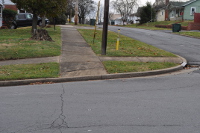ADA May Require Agencies to Implement Curb Ramp Improvements during Resurfacing Projects
Adapted from FHWA and USDOT websites
Without curb ramps, sidewalk travel in urban areas can be dangerous, difficult, or even impossible for people who use wheelchairs, scooters, and other mobility devices. Curb ramps allow people with mobility disabilities to gain access to the sidewalks and to pass through center islands in streets. Otherwise, these individuals are forced to travel in streets and roadways and are put in danger or are prevented from reaching their destination; some people with disabilities may simply choose not to take this risk and will not venture out of their homes or communities.
The Americans with Disabilities Act (ADA) does not require public agencies to provide pedestrian facilities. However, when a public agency provides a pedestrian facility, it must be accessible to persons with disabilities to the extent technically feasible. An important part of this requirement is the obligation whenever streets, roadways, or highways are altered to provide accessible curb ramps where street level pedestrian walkways cross curbs. This requirement is intended to ensure the accessibility and usability of the pedestrian walkway for persons with disabilities.

An alteration is a change that affects or could affect the usability of all or part of a building or facility. Roadway surface treatments that are considered to be alterations include: reconstruction, rehabilitation, open-graded surface course, microsurfacing, thin-lift overlays, cape seals, and in-place asphalt recycling.
Treatments that serve solely to seal and protect the road surface, improve friction, and control splash and spray are considered to be maintenance because they do not significantly affect the public's access to or usability of the road. Roadway surface treatments that are classified as maintenance include: crack filling and sealing, surface sealing, chip seals, slurry seals, fog seals, joint repairs, spot high-friction treatments, diamond grinding, and pavement patching. In some cases, the combination of several maintenance treatments occurring at or near the same time may qualify as an alteration and would trigger the obligation to provide curb ramps.
Resurfacing is an alteration that triggers the requirement to add or upgrade non-compliant curb ramps roadway spanning from one intersection to another, and includes overlays of additional material to the road surface. A project that involves milling an existing road, and then overlaying the road with material, regardless of whether it exceeds the height of the road before milling, falls within the definition of "alteration" because it is a change to the road surface that affects or could affect the usability of the pedestrian route (crosswalk).
Crosswalks constitute distinct elements of the right-of-way intended to facilitate pedestrian traffic. Regardless of whether there is curb-to-curb resurfacing of the street or roadway in general, resurfacing of a crosswalk also requires the provision of curb ramps at that crosswalk.
An alteration project must be planned, designed, and constructed so that the accessibility improvements within the scope of the project occur at the same time as the alteration. The ADA does not stipulate how to perform simultaneous accessibility improvements. For example, a public agency may select specialty contractors to perform different specialized tasks prior to completion of the alteration project or concurrently with an ongoing project. If curb ramp improvements are needed in the vicinity (but beyond the limits) of an alteration project, it is often cost effective to address such needs as part of the alteration project, thereby advancing the public entity's progress in meeting its obligation to provide program access to its facilities.
Finally, public entities should not structure the scope of work to avoid ADA obligations to provide curb ramps when resurfacing a roadway. For example, resurfacing only between crosswalks may be regarded as an attempt to circumvent a public entity's obligation under the ADA, and potentially could result in legal challenges.
For additional information on accessibility improvements that may be required as part of resurfacing projects and other roadway alterations, please visit the following web sites:
- "Questions and Answers About ADA/Section 504," FHWA Office of Civil Rights, http://www.fhwa.dot.gov/civilrights/programs/ada_sect504qa.cfm
- "Department of Justice/Department of Transportation Joint Technical Assistance on the Title II of the Americans with Disabilities Act Requirements to Provide Curb Ramps when Streets, Roads, or Highways are Altered through Resurfacing," United States Department of Justice Civil Rights Division, http://www.ada.gov/doj-fhwa-ta.htm
- "QUESTIONS & ANSWERS: Supplement to the 2013 DOJ/DOT Joint Technical Assistance on the Title II of the Americans with Disabilities Act Requirements To Provide Curb Ramps when Streets, Roads, or Highways are Altered through Resurfacing," United States Department of Justice Civil Rights Division, http://www.ada.gov/doj-fhwa-ta-supplement-2015.html
- "Glossary of Terms for DOJ/DOT Joint Technical Assistance on the ADA Title II Requirements to Provide Curb Ramps When Streets Roads or Highways are Altered Through Resurfacing," United States Department of Justice Civil Rights Division, http://www.ada.gov/doj-fhwa-ta-glossary.htm
Back-Contents-Forward